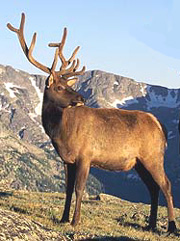 Deer shed their antlers annually as a prelude to the regeneration, or re-growth, of
new ones. Deer shed their antlers annually as a prelude to the regeneration, or re-growth, of
new ones.
The entire shedding process takes a mere two to three weeks to
complete, and the re-growth phase takes place over the summer. The
docile male deer that, with the
exception of the male and the female reindeer, solely sports antlers, sheds them between January
and April, after the autumn mating
season draws to a close. He can do
without antlers at this time, because his need for them in prior
months, to attract and to impress females for his harem of mates, and to fight with his
competitors for the females' affections, no longer exists.
The antlers themselves differ from the hollow horns of cattle, in
that they comprise solid bone tissue with a honey combed structure.
Pedicles, or knobby, skin-covered nubs protruding from the skull, support the
deer's antlers, or points, which range in number from one shaft to
eleven branches. The pedicles are a permanent fixture on the deer's
forehead, and are the point from which the antlers annually break
off.
During the first year the pedicles appear on the young deer's
forehead. The following year, the youngster sprouts straight,
spike-like shafts, and in the third year, the first branch appears.
In successive years, as the deer matures, his antlers lengthen and,
in most species, he acquires additional branches. One can actually
determine the age of the deer from the number of branches on his
antlers, as their number increases with age.
During the growth phase of the bony antlers, they are covered
with a sensitive skin referred to as "velvet“, which is filled with blood vessels
that feed the antlers the vitamins and the minerals necessary to
build up the bone, and to promote normal antler growth. Antler
growth spans two to four months, after which time the velvet is no
longer needed, and a ring, which effectively serves as a shutoff
valve, forms at the base of the antlers and cuts off the blood
supply to the velvet. As a result, the velvet withers, dries up, and
falls off, often assisted by the deer, which rubs his antlers
against tree bark. The antler regeneration is complete, and the
shedding cycle will resume once mating season in the fall
concludes. |
|
note:
|
prelude: 前奏
docile: 温顺的
sport: 炫耀,卖弄
mating: 交配
draw to a close: 渐近结束
harem: 一群雌动物
pedicle: 肉茎
knobby: 多节的
nub: 小块
velvet: 天鹅绒
| |
